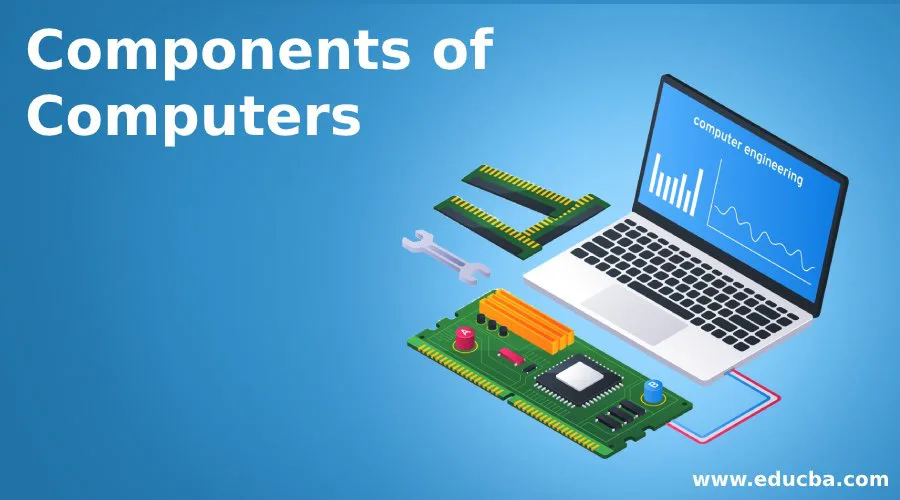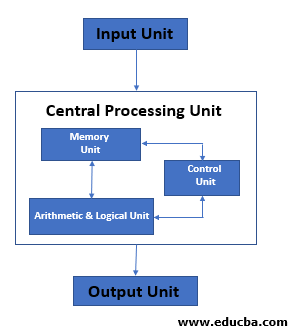
Introduction to Components of Computers
Components of Computers can be defined as the various vital elements of the computer system that makes the device fully functional and to run without any procedural troubles. It is typically referred to the basic hardware units that complete the structural architecture of the computer system. It is important to notice that the device does not work normally even if any one of the components is missed or not working as per the fundamental computer architecture. Every computer should have these essential components placed inside them, in order to be qualified for the instrument to be called as a computer system.
Components of computers
The main components of a Computer System’s Architecture and their functional flow are as below,
- Input unit
- Processing unit
- Output unit
Though these components are capable of working independently, in order to make the computer system to give accurate outcomes, it is important for these components to function in harmony with one another. There are many devices qualified as both input and output units for the computer systems.

1. Input Unit
The input unit is the beginning of the computation process where the process completely involves the user interaction, as this component is responsible for capturing the input from the user so as to command or instruct the other components of the computer. This process gives a lead to the computer on what to work and lets the next component to decide on how to brew up the results for the given input. There are multiple input devices available for performing this activity, and it depends on the type of input required for specific tasks.
The following are some of the commonly used input devices for carrying out the activities of the input unit are,
- Keyboard: Keyboard device, as the name says, comprises of a bunch of keys and these keys are used to type the instructions and input commands on the computer system. This device acts as an entity that lets the system to record the input provided by the user, and the typical format used to build this type of device is the QWERTY format, along with other functional keys like F1 to F12, ALT, CTRL, Shift, etc. keys.
- Mouse: Mouse is another commonly used input device that is used for pointing and clicking, which comes with a scroll wheel for scrolling through the display and a couple of buttons for selection purposes.
- Joystick: Joystick is an input device that is used for sending out commands for the gaming processes carried out in the computer system. It is made up of multiple control buttons and at least one lever control, and hence it has been given the name ‘Joystick’.
- Touch Screen: Touch Screens are the latest advancement for sending out inputs to the computing devices, where the user just has to use the touch sensible screens to instruct the computer. The touch-action can be performed by a dedicated pen-like device called ‘Stylus’, or even by using the user’s fingertips.
2. Central Processing Unit
The Central Processing Unit is commonly referred to as the CPU that is generally used for fetching the input data or instructions from the input units and converting the unprocessed input data into a machine-readable format, which makes it easy for the computer to carry out the processing activities. It is made of three different units in them, namely, the Memory Unit, the Control Unit, and the Arithmetic & Logical Unit. Popular Course in this categoryAll in One Software Development Bundle (600+ Courses, 50+ projects)600+ Online Courses | 3000+ Hours | Verifiable Certificates | Lifetime Access
4.6 (3,144 ratings)Course Price
₹8999 ₹125000
View Course
Related CoursesWindows 10 Training (4 Courses, 4+ Projects)JWS Java Web Services Training (4 Courses, 11 Projects)Java Training (40 Courses, 29 Projects, 4 Quizzes)
- Memory Unit: This Unit is used for numerous purposes like storing the data received from diverse input devices, providing the necessary space for handling the computational activities, caching the previous calculations, reserving space for upcoming activities, buffering the temporary information, etc.
- Control Unit: This is the most intricate unit in the processing component of the computer system, which accepts the raw data from the input components, and carries out the activities in a controlled format, in accordance to the directions provided by the computer operators. This is another unit of hardware module located inside the central processing unit.
- Arithmetic & Logical Unit: The Arithmetic & Logical Unit plays a significant role in the workings of the computer device, where the relevant operations and logical functions are concluded. This unit works in collaboration with other units, like any other component in the computer system, by using the input information from the input unit and by using the memory/ control units for performing various jobs to achieve a flawless end result.
3. Output Unit
The Output Unit, similar to the input unit, is designed only for the sole purpose of interacting with the user of the computer system. It is normally used to give the processed results to the user, based on the input provided by the user themselves. The devices that handle the output processing should be capable of delivering any type of data or a combination of data types on their display units, including text, numbers, images, audio, video, gifs, etc.
Here are the few commonly used output devices,
- Monitors: The computer monitors are responsible for displaying the results received after processing and completing all the operations in the central processing unit. The technology in designing the display devices have evolved from monochrome monitors to colored monitors to the latest LED/ LCD displays.
- Printers: Printers are another form of output devices, similar to the monitors, but the difference is the output data received are produced into hard copies. The performance standards of the printer device are qualified based on the processing speed, the printing resolution, the processing memory capacity, printing color feature, etc.
- Speaker: Speakers are used for obtaining the audio formatted output data, which comes with a variety of extensions like.MP3, MPEG, .WMA, etc. This device aids in actions like sending out audible alerts to the user, to access the data with music or audio, communication systems, etc.
Conclusion
Computer components are the crucial parts of the computer system, which serves their own functions both independently and by complementing to other components inside the system. A computer system cannot perform to the fullest as a complete efficient & performing device unless all these components are working without any glitches.
Recommended Articles
This is a guide to Components of Computers. Here we discuss an introduction to Components of Computers, architecture, and functional flow. You can also go through our other related articles to learn more –
